


 251a
Reconstructing the
251a
Reconstructing the
Johannine Community IIa
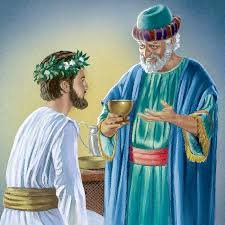
Introduction to the Mystery of Cana,
Marriage & the Resurrection
Third Expanded Edition: 24 April 2024

Continued from Part 1
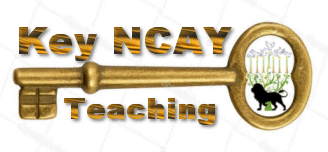
A Short Introduction to the Johannine Community
Shabbat shalom and welcome back to the second part of our Reconstructing the Johannine Community series that was originally published as teaching material for the School of the Elders around this time 24 years ago when I started to share some of the deeper truths about the teaching and ministry of the Apostle John. A lot of new light and truth has come forth in the quarter of a century since so my task today is to bring the original material up to speed. Today's message is an entirely new introduction to the subject. Next week I will start sharing some of the meatier truths, also updated and expanded from the original teaching shared in 2000.
The Messianic Community's Foundational Truth
To understand what I am about to share with you is so you can understand how the early Messianic Community (Church) evolved and matured in the half century that had elapsed since Yah'shua (Jesus) anounced what the Messianic Community (Church) would look like based on the foundational truth found in the revelation given to the apostle Peter at Caesarea Philippi. Let's refresh our memories on this important event so we have this crystal clear in our minds from the outset:
"When Yah'shua (Jesus) came to the region of Caesarea Philippi, He asked His talmidim (disciples), 'Who do people say the Son of Man is?' They replied, 'Some say John the Baptist; others say Elijah; and still others, Jeremiah or one of the nevi'im (prophets).'
"'But what about you?' He asked. 'Who do you say I am?' Simon Peter answered, 'You are the Messiah (Christ), the Son of the living Elohim (God).' Yah'shua (Jesus) replied, 'Blessed are you, Simon son of Jonah, for this was not revealed to you by man (flesh and blood), but by My Father in Heaven. And I tell you that you are Kefa (Peter = Gk. Petros, which means 'detatched stone' or 'pebble' - Heb. masc.), and on this rock (Gk. petra - bedrock; Heb. kefa - fem.) I will build my community (church), and the gates (power) of Sheol (Hades, Tartarus) [1] will not overcome it. I will give you the keys (authority, Is.22:22) of the Kingdom of Heaven; whatever you bind (prohibit) [2] on earth will be bound (prohibited) in Heaven, and whatever you loose (permit) [3] on earth will be loosed (permitted) in Heaven.' Then He warned His talmidim (disciples) not to tell anyone that He was the Messiah (Christ).
"From that time on Yah'shua (Jesus) began to explain to his talmidim (disciples) that He must go to Jerusalem and suffer many things at the hands of the elders, chief priests (cohenim) and teachers of the Torah (Law), and that He must be killed and on the third day be raised to life. Peter took him aside and began to rebuke him. 'Never, Master!' he said. 'This shall never happen to You!' Yah'shua (Jesus) turned [his back] and said to Peter, 'Get behind me, Satan! You are a stumbling block (obstacle) to Me; you do not have in mind the things (perspective) of Elohim (God), but the things (perspective) of men.'
"Then Yah'shua (Jesus) said to His talmidim (disciples), 'If anyone would come after Me, he must deny himself and take up his cross and follow Me. For whoever wants to save his life (nefesh) will lose it, but whoever loses his life (nefesh) for Me will find it. What good will it be for a man if he gains the whole world, yet forfeits his soul (nefesh, life)? Or what can a man give in exchange for his soul (nefesh, life) [4]? For the Son of Man is going to come in his Father's glory with his malakim (angels), and then He will reward each person according to what he has done (his conduct). I tell you the truth, some who are standing here will not taste death before they see the Son of Man coming in His kingdom'"
(Mt.16:13-28, NIV; cp. Mk.8:27-38).
 Peter the rock
Peter the rock
What is the Bedrock of the Faith?
In other words, the bedrock on which the Messianic Community (Church) is built is fourfold:
- 1. Christ Himself;
- 2. Peter's confession of faith in Yah'shua (Jesus) as the Messiah (Christ) (v.16);
- 3. Christ's teachings as a whole - one of the great emphases of Matthew's Gospel; and
- 4. Peter himself as a leader in the Messianic Community (Church) as understood in terms of his very clear rôle as head apostle on the day of the first Messianic Shavu'ot, Weeks, Ekatost or as it's popularly (but erronesously) called, 'Pentecost'. This fourth rôle is elevated to a position of importance as the primary meaning to the first rank by the Roman Catholic Church which claims Peter was the first Bishop of Rome and therefore 'Pope' (he wasn't either). It says this in order to bolster its claim to supreme legal, apostolic authority and therefore to be the one-and-only-true-church.
Understanding John in Relation to Peter
In other words, Christ, not the so-called 'Vicar of Rome', is the head of the Messianic Community (Church). We enter, join or become a part of that community not by signing a membership roll, but by receiving a revelation, as Peter did, making a confession of faith, and being physically baptised by complete immersion in the presence of witnesses who will both hold us accountable as well as help us along the way in our discipleship. That revelation is not just to our minds but to our heart and the very spirit that lies at the core of our being. That revelation is that Yah'shua (Jesus) is who He claimed to be, and what the rest of the New Testament claimed He was (as understood by the Apostles' Creed which is our confession of faith). That same revelation is what Christ and the apostles taught in the New Testament. And (importantly for this study in particular), that same revelation acknowledges that Peter was the first Presiding Patriarach (not Pope), the Senior Apostle of a Quorum of an inner circle of Three spiritual fathers - the Patriarchate. That inner circle consisted of James and John who each became the Presiding Patriarch in turn as the one senior before him died. Peter presided over the 12 Apostles and Messianic Community (Church) in the early part of the first century (beginning on that day in Caesarea Philippi), James presided in the middle part of the first century, and John in the last two or three decades of it. So when we are reading John's Gospel, three epistles and Book of Revelation, he is by then the Chief Apostle and First Patriarch presiding over a much matured Messianic Community (Church). As such, then, we would expect the spirit of John's writings to reflect that maturity. And it does. It reflects over half a century of service and communion with both the living and resurrected Messiah.
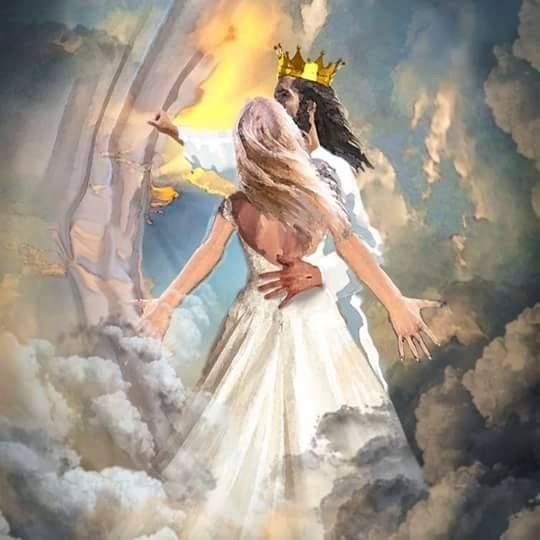 The Bride of Messiah is a picture of the sacred feminine
The Bride of Messiah is a picture of the sacred feminine
John's Unique Witness
So this incident establishes, very importantly and clearly, what the Messianic Community (Church) is, how it is to be built, and who is called to lead it. To understand that better we must read the writings of Peter, James and John themselves. Incidentally, John does not record the Caesarea-Philippi incident in his Gospel but interestingly, as I pointed out last week, makes mention of a similar tesimony of the messiahship of Yah'shua (Jesus) given by Martha in a moment of crisis following the death of her brother, Lazarus (Jn.11:17-27). The apostle John is not seeking to systematically duplicate what the other three evangelists (Matthew, Mark and Luke) have written but, in addition to appealing to a particular kind of Greek audience in his part of the world (centred around Ephesus), seeks to reveal deeper truths especially concerning the sacred feminine but much more besides. He alone of the four Evangelists, for example, has not one but two Creation Narratives like that of Genesis 1 in the first chapter pof both his Gospel and First Epistle! He alone of the apostles has been shown the very beginning (John 1; 1 John 1) and the very end (Book of Revelation) of all things!
Recasting Peter's Confession in the Mouth of Martha
Thus the confession Peter made is recast by John as the confession of Martha too so that, amongst other things, he builds on Yah'shua's (Jesus') own teachings and actions in welcoming women to be His talmidim (dsciples) and treating them with respect and dignity, thus ensuring everyone understands that women are not inferior beings as the Judaism of the first century portrayed them as being but are co- or joint-heirs of salvation (Rom.8:17) in exactly the same way as the men. To which John testifies that they are in possession of a sacred truth which their gender alone can properly reveal in its fullness, which is the theme of this year's sermons (2024-5) on the Eden-Astara Principle.
 The Eden-Astara Principle is one of the deep truths hidden in John's writings
The Eden-Astara Principle is one of the deep truths hidden in John's writings
Piecing Together the Johannine Mystical Tradition
Now we here at Messianic Evangelicals have long claimed to possess a considerable amount of revelation on this subject. Many of our revelations are about women, for women. My purpose today and in the weeks ahead will be to look solely at the Johannine writings in the Bible and piece together the various clues pointing us to the very earliest Christian/Messianic esoteric/mystical tradition which are to be found in the New Testament, traditions that Roman Catholicism has either sought to suppress or deflect attention away from by transferring the truth about the sacred feminine to the Virgin Mary by idolatrously elevating her as a co-Redemptrix (co-Saviour with Christ) and into virual godhead itself as the 'Mother of God'. (Mormonism, incidentally, also followed this Catholic tradition in its earliest days, referring to the Virgin Mary as the 'Mother of God' in the first edition of the Book of Mormon - 1 Nephi 11:18. This was changed by Joseph Smith in the second edition to 'Mother of the Son of God').
Understanding What the 'Divine Feminine' Is and Isn't
Now in saying all this, please don't misinterpret me as being in any way 'New Age'. In what I am about to share I am following no school of external theological thought, no teachings of other non-Christian religions, but am basing my discoveries on simple observations of the Johannine biblical texts, on our current historical knowldedge of the latter part of the first and early second centuries AD/CE, and on the inspiration of the Ruach haQodesh (Holy Spirit) given to me. That is the agenda, so as to be perfectly clear. We are not - I repeat, not - endorsing any sort of occultism which we utterly repudiate as satanic.
Not New Age or Occultic Goddess Worship
So when I speak of the 'divine' or 'sacred female' I am not saying women are goddesses, godlets or divine, nor am I referring to 'goddess worship', so called. That's a kind of religious pagan feminism and is roundly condemned in the Bible. We worship Yahweh, our Heavenly Father, through His Son, Yah'shua the Messiah (Jesus Christ) alone and in all circumstances because that's what we are taught to do in Scripture. That's the formula of the Master's or Lord's Prayer. Power isn't the name-of-the-game either but the nature or quality of the Ruach (Spirit):
"Not by might nor by power, but by My Ruach (Spirit),' says Yahweh of armies (hosts, tsevaoth)" (Zech.4:6, NKJV).
Not Feminist Power Politics
Neither are we liberal Christians making a Marxist anti-patriarchal political statement or advocating a power struggle in which women seek to overturn male headship and so change biblical rôles. We are here only to uncover and understand biblical truth, building on what is already known and applying it. I hope that's crystal clear because we have many false accusers out who try to make us out to be teaching things we are not.
 Feminism is all about acquiring power
Feminism is all about acquiring power
Differences Between John and the Synoptists
Last week I commented on the style and approach of John which differs markedly from the three Synoptists, Matthew, Mark and Luke in order to underline the fact that the apostle's method of instruction is not so much a chronological account of the life of Messiah with running explanations but a doctrinal treatise in which historical events serve as illustrations of the bigger, 'eternal' picture. I illustrated that, you may remember, by use of a cube. We have seen that the apostolic "inner circle" of Peter, James and John consists not only of the early Community's (Church's) core leadership - the Presiding Fathers or Patriarchs (Patriarchate) - but we learn from the several writings of these men that there were major functional differences in leadership rôles.
The Inner Circle Apostolic Witnesses
It is the belief of Messianic Evangelicals that the apostle John was not only, ultimately, the leading, senior apostle holding the keys and authority as Peter once had done (and James before him), but that he was also given a sacred custodianship of deeper spiritual truth that the world was too immature to receive in the first century. To all intents and purposes this became lost in the various Catholic and Gnostic struggles for ascendency. What of the other two leaders? We know most about Peter to whom was given a distinctly exoteric or outward Besorah (Gospel) and upon which the Catholic, Eastern Orthodox and Protestant Churches have built their belief systems though all three have maintained different aspects of a gnostic-corrupted Johannine tradition. The Petrine (Peter) witness is mostly concerned with externals such as ecclesiastical authority, administration, and the simple truths of the Christian Evangel such as salvation by faith. As for James (Heb. Ya'akov = Jacob), we must not forget that there were two of them, which sometimes confuses Bible-readers. We recall that the first was martyred early in the post-'Pentecost' ministry and was, it is believed, succeeded by James, the half-brother of Yah'shua (Jesus).
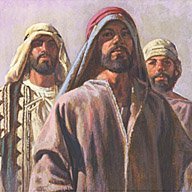 The inner circle of three apostles
The inner circle of three apostles
The Three Overlapping Apostolic Traditions
The Jamesian (Jacobian - James) tradition stands somewhere between the Petrine (alef/alpha/spring fetsivals) and the Johannine (taw/omega/autumn festivals) and is pastoral and mesoteric, tolding the two (Petrine and Johannine - Peter and John) together. More's the pity that we only have one writing of James which ranks very highly in the Aramaic Tradition and is placed right after the Book of Acts. Thus the New Testament Community (Church) was, we find, governed by a 'trinity' of persons with offices that are differentiated, as well as overlapping, like the triune Elohimhead (Godhead) itself.
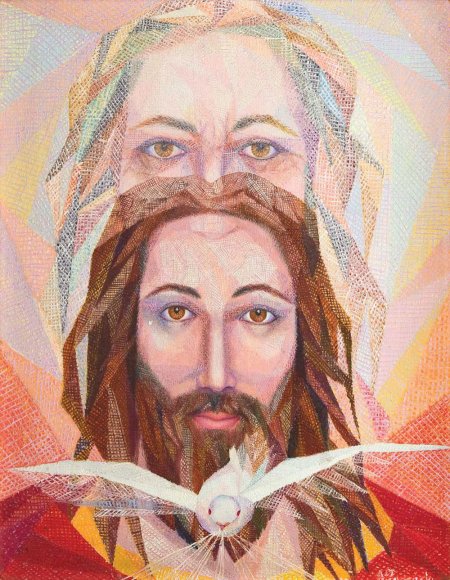 The Triune Elohimhead
The Triune Elohimhead
Corruption and Perversion of the Original Tradition
As soon as the Messianic Community (Church) lost its third and last Patriarchal head, John, within a couple of generations it began to rapidly crystalise and atrophy into a monolithic institution with little or no revelation. In place of a Presiding Patriarch, who was a navi (prophet), seer and a revelator to the Body, those later post-apostolic Christian convened Councils to resolve doctrinal issues and established scriptural canons by debate and democratic vote. The Johannine esoteric tradition became lost, remnants of it being taken up by gnostics who twisted and perverted it into "another gospel", bequeathing their heresy in ever mutating outer forms to their modern day successors such as the Rosicrucians, Illuminati, Kabbalists, Freemasons, other pseudo-Christian and anti-Christian orders. We shall not today trouble ourselves with their heresies which I have written about elsewhere but rather let's return to the canonical Johannine writings and see what the Patriarch is trying to tell us from pure sources.
Tips of the Hidden Gospel
As I said last week, John was not teaching another Besorah (Gospel) but an amplification of the Petrine and Pauline traditions which represent a semi-crystalisation comprehensible to the masses. Yahweh, as we observe, does not reveal everything about Himself to man, in fact, precious little. We are reminded by the navi (prophet) Isaiah that the Eternal's thoughts are still far removed from our own (Is.55:9). We must therefore be content to think on levels that we can comprehend as finite human beings.
Denominationalism
In a pastoral sermon I gave on 8 April 2000 called The Chosen Race I explained why Christendom is, in part, divided into many hundreds of sects and denominations. On the positive side, this is to ensure that Israel is gathered for breeding purposes as well as to administer different aspects of the Besorah (Gospel) in proportion to the willingness of souls to receive it. On the negative, it reflects the effective division caused by demonic powers who do not wish to see an empowered New Testament Messianic Community (Church) restored, one that will shake Satan's kingdom and deliver the elect from delusion. Where previous attempts have been made to bring together the Johannine teachings into the light of day there has, almost without exception, been a corrupting influence in the form of the Gnostic writings from which these parties have tried to excise the apostle's doctrine. This has led virtually all of them into varying degrees of the occult and away from the biblical Christ. Though NCAY has, to be sure, examined the gnostic traditions, we have built up our knowledge almost entirely from the biblical Johannine writings themselves. Whilst this has been a time-consuming process this has at least ensured that we have kept within the generally acknowledged minimum canon of truthful and uncorrupted original sources, the Protestant Canon.
Unity of all Four Gospel Writers
We will now examine a number of pieces from the Johannine texts and assemble them as we go along. To begin with it must be stated that all four New Testament evangelists (Matthew, Mark, Luke and John) uniquivocably state the facts of the life, crucifixion and physical resurrection of Yah'shua (Jesus), leaving no room whatsoever for occultic teachings. The basic doctrines of the Christian/Messianic emunah (faith), as stated in the Apostles' Creed, are coherent and unimpugnable. Matthew, Mark, Luke and John are all completely united as to the saving principles of the Gospel. And so long as we remain within these parameters we shall remain spiritually sound.



 The four gospels are of the same spiritual mind and are echad
The four gospels are of the same spiritual mind and are echad
Apparent Paradoxes
As we look at the various Johannine pieces we will do well to notice that there are seemingly endless "paradoxes". These paradoxes, however, are only apparent - they are quite illusiory - and have been placed by the Ruach haQodesh (Holy Spirit) in the texts to deflect those who are not filled with the Ruach (Spirit) from the truth. Some of Christ's parables contain such paradoxes such as the commandment to eat His flesh and drink His blood (Jn.6:41-66) which appears to contradict the clear ban on cannibalism. But then Yah'shua (Jesus), as all regenerated believers know, was not speaking literally. Neverthless that teaching was enough to drive away those literalists who did not exercise true faith in Him. The emet (truth) of Messiah is only ultimately comprehensible to those who are indwelt by the Ruach (Spirit) - to everyone else it is incomprehensible and foolish. Only John records this saying, by the way. But even those indwelt by the Ruach (Spirit) sometimes have problems with the apparent "paradoxes" and that is because the Besorah (Gospel) is frequently taught from different vantage points or spiritual loci to ensure it is properly understood.
Detecting an Enemy Transmitter
It's rather like the radio transmitter detectors used in the last world war. To catch an enemy agent you needed two detector vans in different places. Each van would get a bearing of the target from their particular vantage point by intercepting a beam. Where the two bearing lines crossed was the point where the enemy transmitter was located. It is the same in the teaching of divine emet (truth) - two seemingly contradictory "facts" are sometimes taught but the point at which they cross is where the emet (truth) is actually to be found. It's a brilliant way of concealing deep truths because you've both got to work hard and seek out the Ruach (Spirit) to discover them. This at once eliminates the spiritually lazy and insincere. But you need both scriptural vantage points first of all and then you need the Ruach haQodesh (Holy Spirit) to show you the meeting point. Sometimes you need more than two, depending how deep and sacred the principle being hidden is. You need two beams for a two-dimensional origin point - length and breadh - but what if it is high up too?
Son of Man & Son of Elohim
Let us take an example. Yah'shua (Jesus) is described as a man just as we are. He is called the "Son of Man" (e.g. Mt.8:10; Mk.2:10; Lk.5:24; Jn.1:51) over 80 times in the New Testament, showing His earthly origin. But He is also described as one having divine attributes, in whom the fullness of the Elohimhead (Godhead) dwelt bodily (Col.2:9). He is thus called the "Son of Elohim (God)". Which is true? Liberals will focus on the Son of Man because they do not believe in supernatural anything, and conservatives will usually first focus on His deity. But He is both. Yah'shua (Jesus) was, and is, Son of Man and Son of Elohim (God). The intersection point is the 'Elohim-' or 'God-Man' much like matter and spirit one day intersecting to give immortal substance.
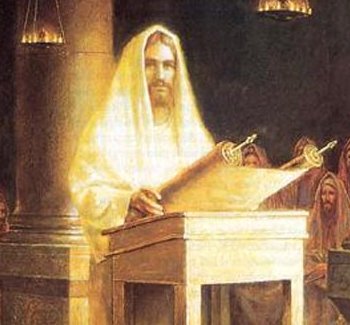 Yah'shua (Jesus) is both Man and Elohim (God)
Yah'shua (Jesus) is both Man and Elohim (God)
Equal or Subordinate to the Father?
Let us take another. In numerous passages Yah'shua (Jesus) is described as being equal with the Father. From these passages the Catholic Church constructed the Trinity doctrine which describes Father, Son and Holy Spirit as completely co-equal. But in other passages the Son is described as being subordinate to the Father and not co-equal, something the Jehovah's Witnesses and Arians in general take as the complete revelation of Yah'shua's (Jesus') deity as a secondary, created "god"; indeed, we are told, that at the end of the Millennium Yah'shua (Jesus) will return His authority to the Father and become eternally subordinate...as Elohim (God):
"The last enemy to be destroyed is death. For He (Christ) 'has put everything under His feet.' Now when it says that 'everything' has been put under Him, it is clear that this does not include Elohim (God the Father) Himself, who put everything under Christ. When He has done this, then the Son himself will be made subject to Him (the Father) who put everything under Him, so that Elohim (God the Father) may be all in all" (1 Cor.15:26-28, NIV).
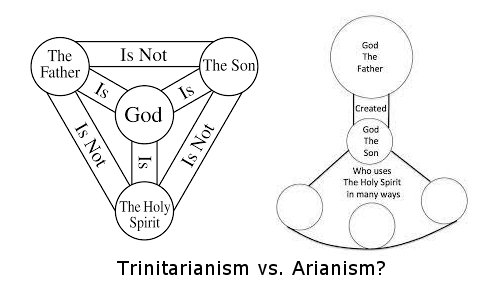 Neither Trinitarianism nor Arianism explain how
Neither Trinitarianism nor Arianism explain how
Yah'shua is both equal with, and subordinate to, the Father
A Temporary Locus
However, both positions are true and the locus is explained as Messiah's current position in the Elohimhead (Godhead). But as John explained to the Corinthians, this will one day end. For now Christ is the Father's Plenipotentiary or Representative in the Universe while He conquers Yahweh's enemies, making Him both equal and subordinate...for now. The Ruach haQodesh (Holy Spirit) occupies a similar locus that we can talk about another time.
Is the Kingdom in Heaven or on Earth?
Let us take one last example. Many scriptures say that the Kingdom of Elohim (God) is in heaven, others that it will be on this world. The solution to this apparent dichotomy is once again very simple - heaven is coming down to earth to fully unite with it one day! For now it exists in pockets, wherever true believers are to be found. It came solely in the person of Yah'shua (Jesus) in the meridian of time and as Christ was received, so it came to men, but at the end of time it will come down lock, stock and barrel. In the meantime, as the Amplified Version of the Bible alone adequately gets across:
"...behold, the Kingdom of Elohim (God) is within you (in your hearts) and among you (surrounding you)" (Lk.17:21, Amp.V).
It's not fully here yet, but it will be when heaven and earth are inseparably connected in resurrection power.
 Is the Kingdom in heaven or on earth...or both?
Is the Kingdom in heaven or on earth...or both?
Finding Wholeness in Christ
It is well to note such pairs of seeming opposites as we look at John for he divides them with great effect - the unspiritual see only the exoteric (outer) twin and rejoice in Elohim (God); whereas the spiritul see the esoteric (inner) twin, marry the two together, and can see the greater picture and experience the greater love What we must not do - and I must stress this - is when we have found the inner or esoteric twin is to forget the outer or exoteric one, for the two are not supposed to be separated. I have met far too many people who, in pursuance of the inner or esoteric, lose their grip on outer reality, having their heads up in the clouds far away from the needs of incarnated people. We exist in both worlds - inner spiritual and outer material. The Besorah (Gospel) is consistently about wholeness - we must not go the occult way and disdain the practical, outer or basic exoterica - if we do, we will most assuredly miss our way. The Besorah (Gospel) of Yah'shua (Jesus) is about earth and heaven united in one (echad), just as the Ruach (Spirit) of the Lesser Yahweh was united in an eternal resurrection to the physical dust of this world to the human Yah'shua (Jesus).
Why Does John Leave Out So Much of the Synoptic Narratives?
The first thing we notice about John's Gospel is that He is not remotely interested in Yah'shua's (Jesus') genealogy or the circumstances surrounding His birth. Were we not to have the Synoptics we would know nothing of the virgin birth and incarnation which Matthew alone describes, making the Gospel of Matthew indispensible. Why this apparent lack of interest? Well, 'apparent' is the key word here. For one, John makes the perfectly legitimate assumption, based on circumstantial foreknowledge, that his readers already know about these things. Though we don't know the exact dates the Gospels were written, it is pretty much the concensus that Mark wrote his first, followed by Matthew and Luke around the same time, with John writing his last of all. Irrespective of the dating you believe to be correct, we can safetly say that Mark's Gospel had been around at least 20 years (but perhaps for as long as 40) before John wrote his. Thus John, whilst utilising material from the Synoptists and merging this with hiw own experience fofr Yah'shua (Jesus) to create his version, assumes his readers are well acquainted with Matthew, Mark and Luke, so he does not feel the need to duplicate everything they say. His audience was different to theirs. These historical events were simply a 'given'. They were 'common currency', as it were, so no need to duplicate them.
How John's Gospel Starts
So from a short theological introduction (Jn.1:1-19) we leap past four Synoptic chapters to Bethany and the testimony of John the Baptist. We are left with no account of the Annunciation, Yah'shua's (Jesus') circumcision, the visit of the wise men, His youth, or even His baptism though there is plenty about the Baptist. Instead we are given an explosive introduction describing Yah'shua as the Eternal Cosmic Davar (Logos, Word) and Creator (Jn.1:1-2) and next we see Him in Cana supernaturally turning water into wine (Jn.2:1-11). And from this point the riddles begin and the detective's magnifying glass must be brought out.
 Genesis, John & 1 John all begin as creation narratives
Genesis, John & 1 John all begin as creation narratives
Going Much Deeper
That and other interesting questions we shall be answering next week as we get into the meat of what really happened at Cana. Today has been a prepping for that important discussion in which you will be challenged to re-evaluate what you have been taught by Western Roman Christianity whether viâ Catholicism or Protestantism unless you're already well acquainted with our 'hot potatoes'. If you are, that will help, though we're going to go far deeper than even these. So I have to warn you that what I have to share next is not for the faint-hearted or for those who are unwilling to be obedient to Yah'shua (Jesus) in literally everything and I fully expect many of you by the end of the next sabbath sermon to either be in shock or to have fled. If you do, that's ok, because that's how most of us initially deal with the unexpected and we can only handle so much. Sometimes a lot of ruminating has to take place. Only a few of the braver ones will hang around to hear more.
Conclusion
For those of you who have access to the Aramaic Peshitta, the Hebraic Roots Version (HRV) or the Restoration Scriptures True Name Edition (RSTNE) [5] I'd like to invite you to look at order in which the books of the New Testament are arranged in those versions and for you to compare that with the arrangement in your Protestant Bibles (like the New King James Version - NKJV). If you use the Jewish New Testament (JNT), the Complete Jeswish Bible (CJB) or the Institute for Creation Research Version (ISRV) these will be of no use for this particular exercise as they all follow the Roman Church's book order. I know everyone here has a copy of the Halleluyah Scriptures messianic version which is worse than useless as far as the listing of New Testament books are concerned as it seems to follow its own unique order. You'll find out why I want you to do some homework on this before next week. So until then, Yahweh bless you and keep you in Yah'shua's Name. Amen.
Continued in Part 2b
Endnotes
[1] The Greek Septuagint (LXX) renders this Tartaroo (Tartarus in Latin) as also found in 2 Peter 2:4. This is a reference to the lower part of She'ol. Shem Tov renders this 'Gey Hinnom', in other words, the 'hell' or 'prison' part of She'ol, the upper part being 'Paradise' or 'Heaven'.
[2] To 'bind' is a Semitic idiom meaning to forbid or prohibit
[3] To 'loose' is likewise a Semitic idiom meaning to allow or permit
[4] For an in-depth understanding of how the word nefesh (life, soul) with its mutliple meanings is used throughout the Bible, see The Bible Teaching on "Soul" and the Soul-Sleeping website. This is a commonly misunderstood word that has led to all sorts of strange denominational teachings.
[5] The RSTNE places Hebrews (Ivrim) between James and 1 Peter for some reason whereas in the HRV it appears right before Revelation.
Further Reading
[1] Rosh Chodesh 2019 XI: The Apostles, Prophets & Christmas - The Gifting I

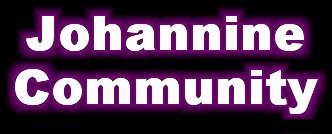

 V464
V464

This page was created on 6 April 2000
Last updated on 23 April 2024
Copyright © 1987-2024 NCAY - All Rights Reserved




